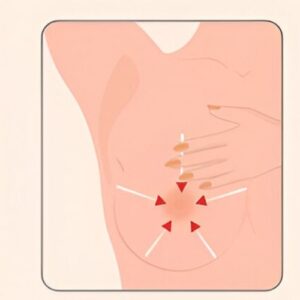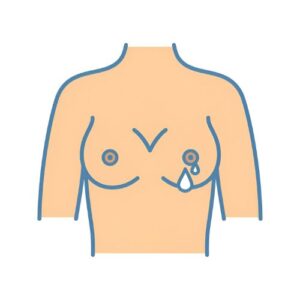A Simple Guide to Breast Self-Examination (BSE)
Breast self-examination is a helpful tool to identify changes in your breasts early. While it is not a substitute for clinical breast cancer screening, it allows you to become familiar with your body. The more regularly you perform a self-breast exam, the easier it is to notice slight changes.
Most healthcare associations recommend performing a breast self-exam monthly, even though it isn’t considered an entirely reliable method for detecting breast cancer. However, research shows that many individuals with breast cancer first noticed something unusual by finding a lump at home. Being familiar with what’s normal for your breasts helps you quickly alert a healthcare provider if any changes occur.
In this blog, we cover how to do a self-breast Examination, what to look for, and the importance of doing it regularly as part of breast cancer screening.
Why Should You Perform a Breast Self-Examination?
Breast Self-Examination helps you familiarize yourself with your breast tissue and detect potential warning signs of breast cancer early. While not all lumps or changes are cancerous, having anything unusual checked by your healthcare provider is always a good idea.
When and How Often Should You Perform a Breast Self-Exam?
- Perform a monthly breast exam.
- If you’re menstruating, try to schedule this a few days after your period ends, when your breasts are less tender or swollen.
- If you’re in perimenopause or post-menopause, aim to perform this activity on the same date each month for consistency.
Which Areas Should You Cover During a Breast Self-Examination?
To thoroughly check your breasts, it’s essential to examine the entire breast tissue, not just the central area. Be sure to cover:
- The upper and lower parts of the breast
- The sides of the breast (including the outer edges closer to the armpit)
- The area around the nipples and areola
- The armpits (axillary region) to check for any lumps or swelling
- The area below the breast (along the rib cage)
- The collarbone area where breast tissue extends
How to Do a Self-Breast Examination – Step-by-Step
Step 1: Visually Inspect in Front of a Mirror 
Stand bare-chested in front of a mirror with your arms at your sides.
Look for the following changes:
- Swelling, dimpling, or puckering of the skin.
- Changes in the size or shape of the breasts.
- Changes in the nipples, such as inversion, discharge, or rashes.
Raise your arms overhead and repeat the observation. Look for any changes in how the breasts move or any uneven appearance.
Observe your armpit for any changes.
Now, place your hands on your hips and press firmly to tighten the chest muscles. Look again for any changes.
Step 2: Touch and feel Your Breasts While Standing or lying dow
Self-Breast Examination in shower:
- Start by taking a warm shower. The warmth will relax your muscles and make it easier to feel for any changes in your breast.
Use Soap or Shampoo
- Apply a little soap or shampoo to your hands. This will help your fingers glide over your skin and make it easier to feel for lumps or changes.
Raise Your Arm
- Raise your left arm over your head to examine your left breast. This spreads the tissue, making it easier to feel.
- Use your right hand to feel the breast and repeat the process on the other side.
Breast self-examination While Lying Down
- Lie down and place a pillow under your shoulder to spread the breast tissue evenly.
- Use the opposite hand to feel each breast, following the same circular motion from the nipple to the outer edges.
Select Patterns: Choose a specific technique to examine your entire breast thoroughly.
1. Circular Method 
- How to Do It:
- Start by placing your fingers at the center of the nipple.
- Use the pads of your three middle fingers to apply light pressure and make small circular motions.
- Gradually increase the size of the circles, moving outward from the nipple.
- Ensure you cover the entire breast, including the area around the armpit (axillary region) and below the breast.
- Purpose: This method helps you feel for lumps or unusual textures throughout the breast tissue. The circular motion allows you to check every area systematically.
2. Vertical Strips Method 
- How to Do It:
- Start at the collarbone and move downwards to the bottom of the breast.
- Use a vertical strip approach, checking small breast tissue sections as you move down.
- You can visualize this as moving your fingers up and down in straight lines, covering the breast in a grid-like pattern.
- Make sure to apply varying pressure—light, medium, and firm—to detect any changes in texture or lumps.
- Purpose: This technique ensures you check the entire vertical length of the breast. It can be particularly effective in detecting lumps hidden at the breast’s top or bottom.
3. Wedge Method
How to Do It:
- Begin at the nipple and work outward in small, wedge-shaped sections.
- Imagine dividing the breast into pie-like segments, with the nipple at the center.
- Check each “wedge” by moving outward, applying pressure with your fingers as you go.
- This technique allows you to cover the entire breast systematically, ensuring no areas are overlooked.
- Purpose: This method provides a thorough examination by checking each segment of the breast tissue, making it easier to notice any lumps or abnormalities.
Step 3: Check for Nipple Discharge 
- Gently squeeze each nipple to see if there is any discharge (clear, bloody, or yellow).
- Any unexpected nipple discharge should be reported to your healthcare provider.
Breast self-examination While Lying Down
- Lie down and place a pillow under your shoulder to spread the breast tissue evenly.
- Use the opposite hand to feel each breast, following the same circular motion from the nipple to the outer edges.
What to Do if You Find Something Unusual?
If you find a lump or notice anything unusual during your self-exam, don’t panic. Many lumps are non-cancerous. However, it’s essential to consult a doctor for further evaluation. Breast cancer screening, including mammograms, can help determine whether further investigation is required.
Incorporate Breast Self-Examination into Your Health Routine
By taking just a few minutes each month to perform breast self-examination, you empower yourself to be proactive about your health. Make it a habit to stand in front of a mirror and check your breasts thoroughly, combining self-exams with regular clinical screenings. Remember, early detection can save lives.
Regular breast self-exams are not a replacement for professional medical exams but are a complementary part of a breast cancer screening plan. Stay consistent, stay aware, and take charge of your well-being.
9Months is a leading hub for pregnancy class and women’s wellness in the Middle East. We empower couples and individuals during the exciting and transformative time of pregnancy and womanhood.
Services
Contact
9Months Health Consultancy
8th Floor, Block A
Business Village, P.O.Box 87556
Dubai, UAE
Copyright © 2024. 9Months. All rights reserved.
Privacy Policy | Terms & Conditions